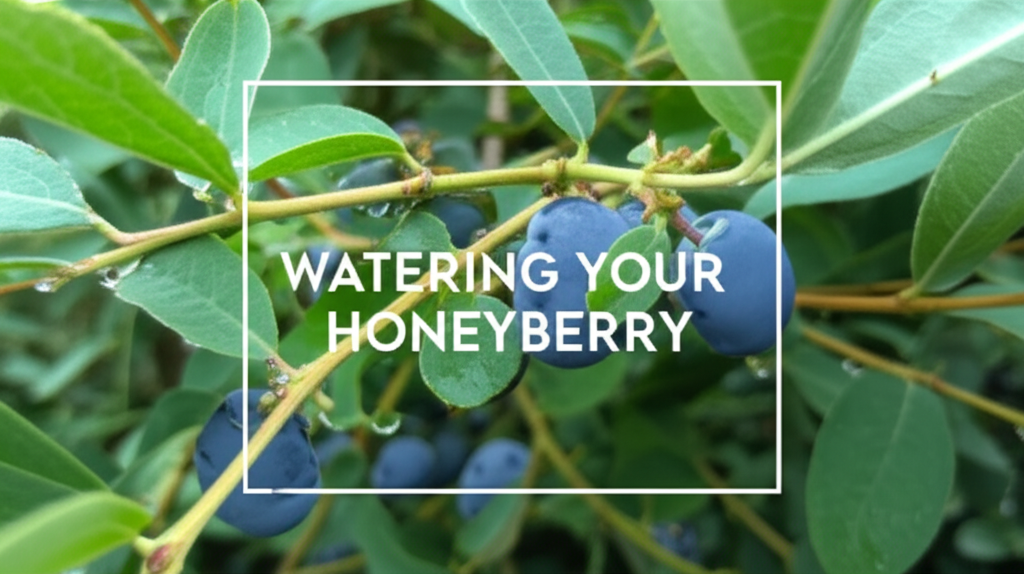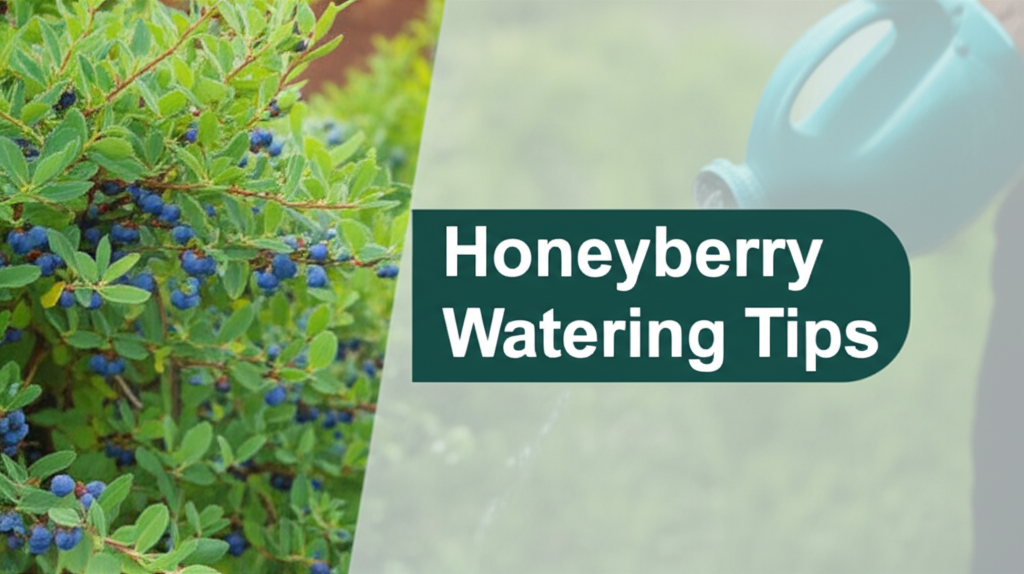The Sweet Secret to Thriving Honeyberries: Understanding Their Watering Needs
Honeyberry shrubs, also known scientifically as Lonicera caeruleae and often called Haskaps, are increasingly popular additions to home gardens. Celebrated for their antioxidant-rich, tart-sweet berries, these hardy plants offer a delicious early-season harvest. However, like any cultivated plant, their success hinges on proper care, and none is more critical than consistent and adequate watering. Overwatering can lead to root rot, while underwatering stunts growth and reduces fruit yield. This guide delves deep into the optimal watering schedule for your honeyberry shrubs, ensuring they flourish and provide you with bountiful harvests for years to come.
Why Watering is Crucial for Honeyberry Success
Honeyberries are native to cold climates, including Siberia, Japan, and parts of North America. This heritage grants them remarkable resilience to frost and harsh winters. However, their native environments often involve consistent moisture availability, particularly during their active growing season. Understanding the plant’s physiological needs is key:
- Root Development: Young honeyberry plants, especially those recently transplanted, require consistent moisture to establish a strong root system. Well-established roots are the foundation for healthy growth and resilience to drought.
- Flowering and Fruiting: The critical periods for flowering and fruit development demand ample water. Insufficient hydration during these stages can lead to blossom drop, poor fruit set, and smaller, less flavorful berries.
- Nutrient Uptake: Water acts as the primary vehicle for nutrient transport from the soil to the plant’s various parts. Proper soil moisture ensures that nutrients are readily available for the honeyberry to utilize.
- Temperature Regulation: In warmer weather, adequate water helps honeyberry plants regulate their internal temperature through transpiration, preventing heat stress.
Factors Influencing Your Honeyberry Watering Schedule

There’s no single, one-size-fits-all watering schedule for honeyberries. Several environmental and situational factors dictate how frequently and deeply you should water. Recognizing and adapting to these variables is paramount for success.
Soil Type and Drainage
The type of soil in which your honeyberries are planted significantly impacts how quickly it dries out.
- Sandy Soils: These soils drain very quickly, meaning they retain less moisture. Honeyberries in sandy soil will likely require more frequent watering.
- Clay Soils: Clay soils are denser and retain moisture for longer periods. Overwatering is a greater risk in clay soils, and it’s essential to ensure good drainage to prevent waterlogging.
- Loamy Soils: Loam, a mixture of sand, silt, and clay, is often considered ideal for gardening. It offers a good balance of drainage and moisture retention, requiring a moderate watering frequency.
It’s crucial to check the soil’s moisture level rather than relying solely on a calendar. Digging a finger a few inches into the soil is the most reliable method.
Climate and Weather Conditions
The prevailing climate and current weather patterns are primary drivers of watering needs.
- Temperature: Higher temperatures increase the rate of evaporation from the soil surface and increase the plant’s water demand through transpiration. During hot spells, watering frequency will need to increase.
- Rainfall: Natural rainfall is the most efficient form of watering. When significant rainfall occurs, you can adjust or skip your planned watering sessions. However, remember that even after rain, the soil may not be uniformly moist, especially under dense foliage or mulch.
- Wind: Windy conditions, particularly hot, dry winds, can accelerate soil drying and increase plant transpiration. Extra vigilance may be needed during windy periods.
- Humidity: High humidity can reduce the rate of evaporation and transpiration, potentially decreasing watering needs. Conversely, low humidity can necessitate more frequent watering.
Stage of Plant Growth
Honeyberry shrubs have different water requirements at various stages of their life.
- New Plants (First Year): Newly planted honeyberries are particularly vulnerable and require consistent moisture for root establishment. Aim to keep the soil consistently moist but not waterlogged.
- Established Plants (Second Year Onward): Once established, honeyberries become more drought-tolerant. However, they still benefit from adequate watering, especially during dry periods.
- During Flowering and Fruiting: This is a high-demand period. Ensuring sufficient water during these stages is critical for a good harvest.
- After Harvest: While growth may slow, continued adequate watering helps the plant store energy for the following year and maintain overall health.
Mulching
A layer of organic mulch around the base of your honeyberry shrubs offers numerous benefits, including moisture retention.
- Moisture Conservation: Mulch acts as a barrier, reducing evaporation from the soil surface.
- Temperature Moderation: It helps keep the soil cooler in summer and warmer in winter, protecting the roots.
- Weed Suppression: Mulch also helps suppress weed growth, which competes with the honeyberry for water and nutrients.
A 2-3 inch layer of organic mulch, such as wood chips, shredded bark, or compost, applied around the base of the plant (leaving a small gap around the trunk) can significantly reduce watering frequency.
Developing Your Honeyberry Watering Schedule
The goal is to provide deep, infrequent watering rather than shallow, frequent watering. This encourages the roots to grow deeper into the soil, making the plant more resilient.
The Finger Test: Your Most Reliable Indicator
The most effective way to determine if your honeyberry needs watering is to check the soil moisture manually.
- Insert your finger about 2-3 inches into the soil near the base of the plant.
- If the soil feels dry at this depth, it’s time to water.
- If the soil feels moist, wait and check again the next day.
Remember to perform this test in several locations around the plant, as moisture distribution can vary.
Watering Frequency Guidelines
While the finger test is paramount, here are general guidelines based on plant age and conditions:
- New Plants (First Season): May require watering every 2-3 days during dry spells, depending on temperature and soil type.
- Established Plants (Dormant Season/Early Spring): Generally require minimal watering unless there’s an extended dry period.
- Established Plants (Growing Season – Spring/Summer): Depending on rainfall and temperature, watering might be needed once every 7-14 days. During prolonged heatwaves or drought, this could increase to once every 5-7 days.
- Late Summer/Early Fall: Continue to monitor moisture, especially if dry conditions persist, to help the plant prepare for dormancy.
Depth of Watering
When you water, ensure it’s deep enough to reach the entire root zone.
- For young plants, aim for about 6-8 inches of soil moisture.
- For established plants, the root zone can extend deeper, so aim for at least 12-18 inches of moist soil.
This means watering for a sufficient duration to allow the water to penetrate. For example, using a soaker hose or drip irrigation for 30-60 minutes might be necessary, depending on your system and soil type.
Watering Methods for Honeyberries
The method you choose for watering can significantly impact efficiency and plant health.
Drip Irrigation
Drip irrigation is an highly efficient method for watering honeyberries.
- Benefits: Delivers water directly to the root zone, minimizing evaporation and runoff. It also helps keep foliage dry, reducing the risk of fungal diseases.
- Setup: Involves a network of tubes with emitters that release water slowly over time.
- Frequency: Can be set on a timer or manually adjusted based on soil moisture checks.
Soaker Hoses
Soaker hoses are another excellent option for consistent, slow watering.
- Benefits: Similar to drip irrigation, they deliver water directly to the soil at the base of the plant. They are generally more affordable and easier to set up than drip systems.
- Placement: Lay the soaker hose around the base of the honeyberry plants, covering the root zone.
- Duration: Water until the soil is moist to the appropriate depth.
Hand Watering
While feasible for a few plants, hand watering can be less efficient for larger plantings.
- Technique: Use a watering can or hose with a gentle spray attachment. Direct the water to the base of the plant, ensuring thorough saturation.
- Considerations: It’s harder to ensure deep, consistent watering with a hose, and it can be time-consuming.
Sprinklers
Overhead sprinklers are generally not recommended for honeyberries.
- Drawbacks: Much of the water is lost to evaporation, and wetting the foliage can encourage fungal diseases, especially in humid conditions.
Troubleshooting Common Watering Issues
Even with the best intentions, you might encounter watering-related problems.
Underwatering Signs
- Wilting leaves (even in cooler parts of the day).
- Dry, brittle foliage.
- Stunted growth.
- Reduced flowering or fruit drop.
- Crispy leaf edges.
If you notice these signs, check the soil moisture immediately and water thoroughly if needed.
Overwatering Signs
- Yellowing leaves, often starting from the bottom of the plant.
- Drooping leaves that look waterlogged, not wilted.
- Stunted growth or failure to thrive.
- Root rot, which can manifest as a mushy, brown root system and a foul odor from the soil.
- Edema (water blisters) on leaves.
Overwatering is often more detrimental than underwatering. If you suspect overwatering, stop watering, ensure good drainage, and consider improving soil aeration.
Key Facts and Comparison of Watering Needs
Here’s a summary of how different factors influence honeyberry watering:
| Factor | Impact on Watering Needs | Action Recommended |
|---|---|---|
| Soil Type | Sandy: Dries quickly | More frequent watering |
| Clay: Retains moisture | Less frequent, ensure drainage | |
| Temperature | Hot: Increases evaporation | Increase frequency/duration |
| Cool: Decreases evaporation | Decrease frequency | |
| Rainfall | Heavy/Consistent: Provides water | Skip/reduce watering |
| Dry/Infrequent: Soil dries out | Increase watering | |
| Plant Age | New: Needs consistent moisture | Frequent, shallow checks |
| Established: More drought-tolerant | Deep, infrequent watering | |
| Mulch | Present: Reduces evaporation | Potentially reduces watering frequency |
| Absent: Soil dries faster | May need more frequent watering |
Steps for Optimal Honeyberry Watering & Pros/Cons
Here’s a breakdown of the best practices and the advantages and disadvantages of different approaches.
| Step/Method | Description | Pros | Cons |
|---|---|---|---|
| Regular Soil Moisture Checks (Finger Test) | Insert finger 2-3 inches into soil. Water if dry. | Accurate, prevents over/underwatering, adaptable. | Requires manual effort, weather-dependent. |
| Deep Watering | Water until soil is moist 12-18 inches deep. | Encourages deep root growth, increases drought tolerance. | Takes longer, requires more water per session. |
| Drip Irrigation | Water delivered slowly to the root zone via emitters. | Highly efficient, minimizes evaporation/runoff, keeps foliage dry, can be automated. | Initial setup cost, potential for emitter clogging. |
| Soaker Hoses | Porous hoses deliver water directly to the soil. | Efficient, good for root zones, relatively low cost, easy to install. | Can be less precise than drip, hoses can degrade over time. |
| Mulching | Apply 2-3 inches of organic mulch around plants. | Conserves moisture, regulates soil temperature, suppresses weeds, improves soil structure over time. | Can harbor pests if too close to the trunk, requires annual replenishment. |
| Avoid Overhead Watering | Do not water from above with sprinklers. | Prevents fungal diseases, reduces water loss. | Requires alternative watering methods. |
Conclusion: Hydration for Honeyberry Bounty
Providing your honeyberry shrubs with the right amount of water is a foundational aspect of successful cultivation. By understanding the influencing factors, diligently checking soil moisture, and employing efficient watering methods like drip irrigation or soaker hoses, you can ensure your honeyberries remain healthy, productive, and a rewarding source of delicious fruit. Remember that observation and adaptation are your most valuable tools in mastering the art of honeyberry watering. Happy growing!


